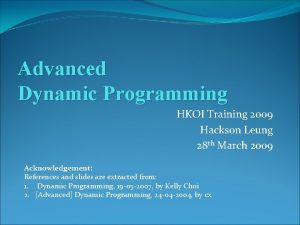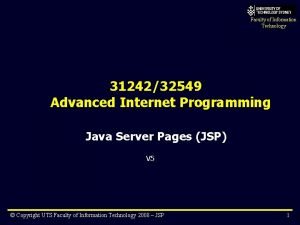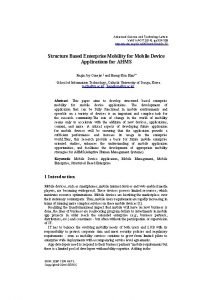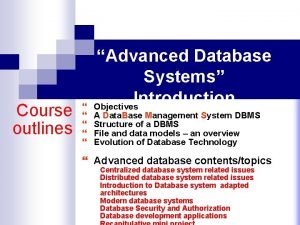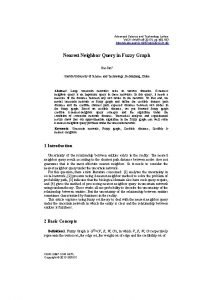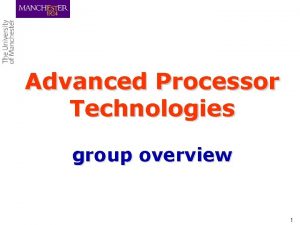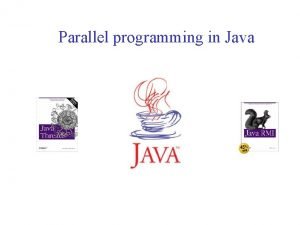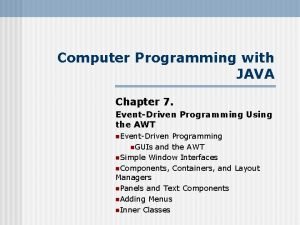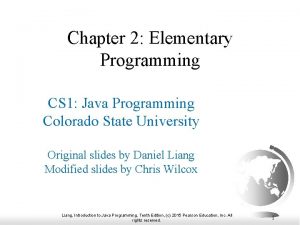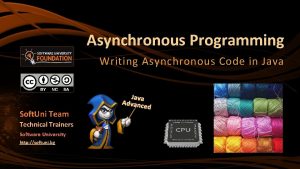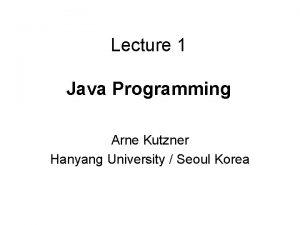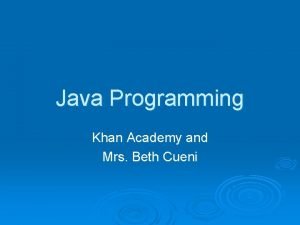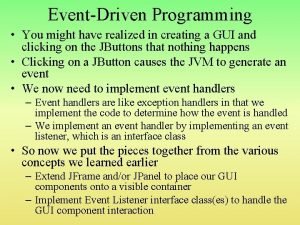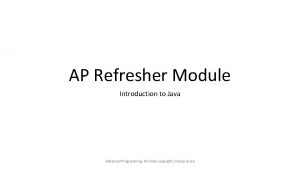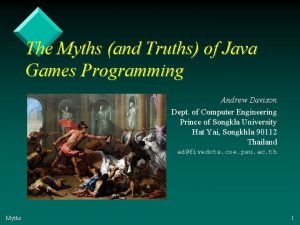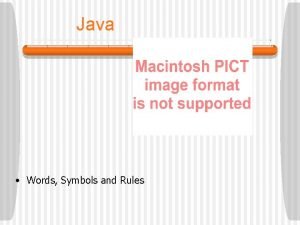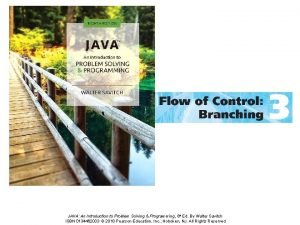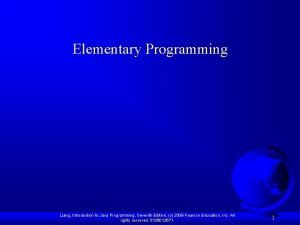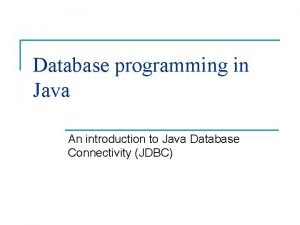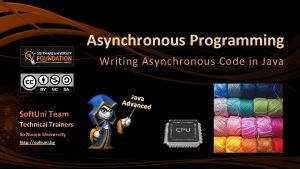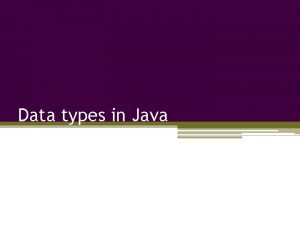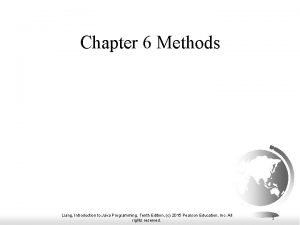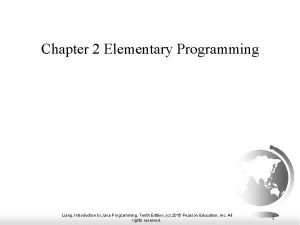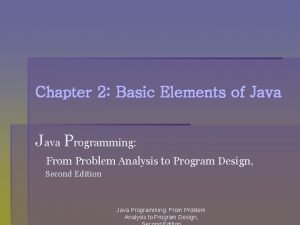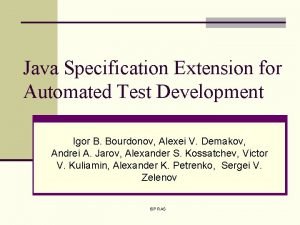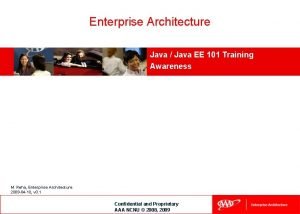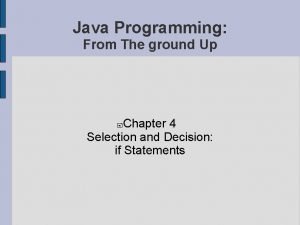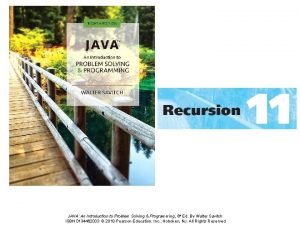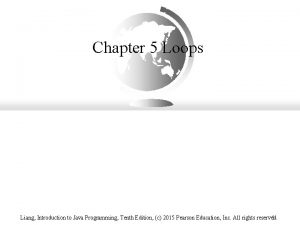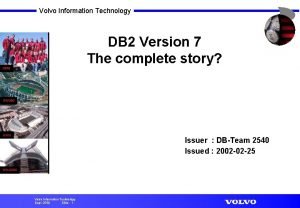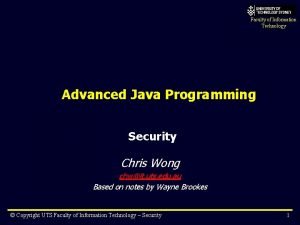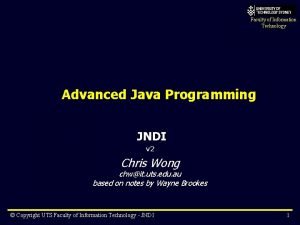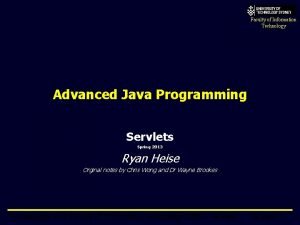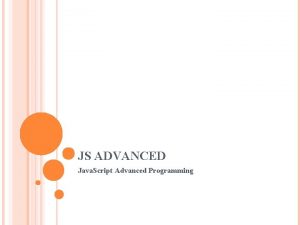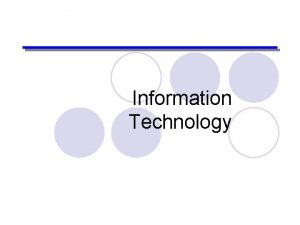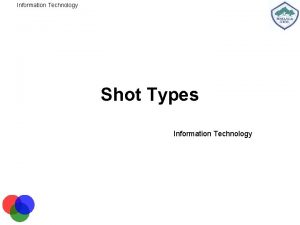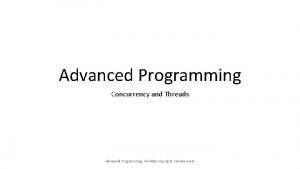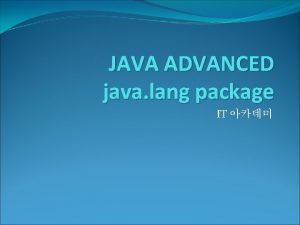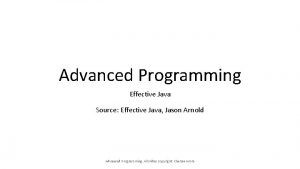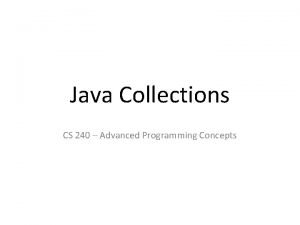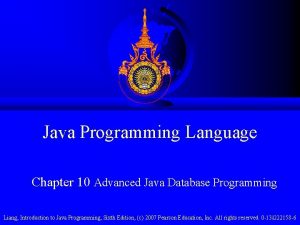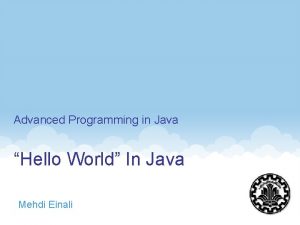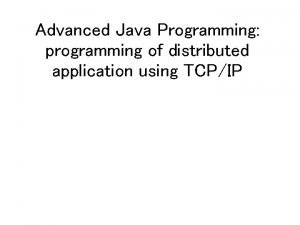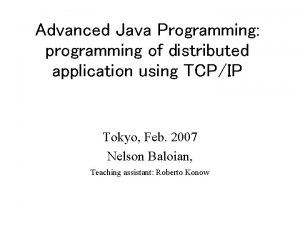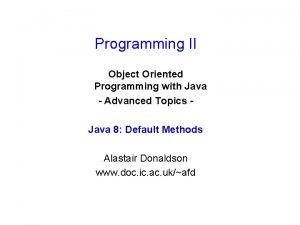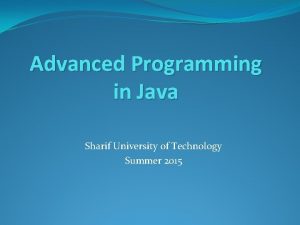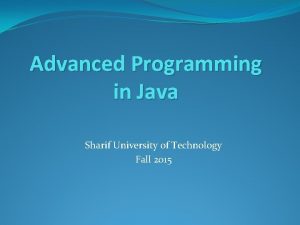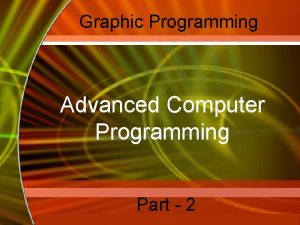Faculty of Information Technology Advanced Java programming Java






























































- Slides: 62

Faculty of Information Technology Advanced Java programming (Java EE) Java Persistence API Based on the JPA presentation from javabeat. net

Topics • Introduction to java persistence • The Java Persistence API – – – Entities Entity. Manager & the Persistent Context Persistence Units Exceptions JPA Query Language Faculty of Information Technology

Introduction • Faculty of Information Technology Previously we learnt about – JDBC – Data Access Objects (DAO) and Data Transfer Objects (DTO) 1. 2. 3. 4. In JDBC, we "hard coded" SQL into our application Then used Data Source/Connection Pooling Then used DAO/DTO But this just "hides" implementation from our business logic, you still implement DAO with JDBC

Issues not solved Faculty of Information Technology • However, – We still have to understand a lot of implementation details (eg: connections, statements, resultsets etc) – What about relationships? Joins? Inheritance? – Object database impedance mismatch • J 2 EE tried to solve this with "Entity Enterprise Java. Beans (EJB)" • Simpler alternatives included Object Relational Mapping (ORM) tools: – e. g. Java Data Objects (JDO), Hibernate, i. Batis, Top. Link

Java EE 5 to the rescue Faculty of Information Technology • Java SE 5 added new constructs to Java language – Generics – Annotations – Enumerations • Java EE 5 used these features to provide – – – Ease of development "Dependency injection" Meaningful defaults, "code by exception" Simplified EJB New Java Persistence API (JPA) replaced Entity EJB

Java EE 5 persistence • • Faculty of Information Technology Java EE 5 still keeps JDBC EJB 3 spec (JSR 220) split into 2: 1. Session Beans, Message Beans 2. Java Persistence API (JPA) • JPA jointly developed by Top. Link, Hibernate, JDO, EJB vendors and individuals • JPA can also be used in Java SE 5 without a container!!!!

Java Persistence Faculty of Information Technology • Java Persistence consists of three areas: – The Java Persistence API – The query language – Object/relational mapping metadata • JPA implementation – Reference implementation: Top. Link (Glass. Fish project) – Most ORM vendors now have JPA interface • eg: Hibernate-JPA, Eclipse. Link (based on Top. Link), Open. JPA (based on BEA Kodo)

Topics • Introduction to java persistence • The Java Persistence API – – – Entities Entity. Manager & the Persistent Context Persistence Units Exceptions JPA Query Language Faculty of Information Technology

Java Persistence API Faculty of Information Technology • javax. persistence. * – – – Entity. Manager. Factory Entity. Transaction Query "Entity" – we use Plain Old Java Objects (POJO) instead.

JPA classes Faculty of Information Technology your application Query Entity. Manager. Factory Entity. Manager JPA provider JDBC driver db db

Entities • • Faculty of Information Technology An entity is a plain old java object (POJO) The Class represents a table in a relational database. Instances correspond to rows Requirements: – annotated with the javax. persistence. Entity annotation – public or protected, no-argument constructor – the class must not be declared final – no methods or persistent instance variables must be declared final

Requirements for Entities (cont. ) Faculty of Information Technology • May be Serializable, but not required – Only needed if passed by value (in a remote call) • Entities may extend both entity and non-entity classes • Non-entity classes may extend entity classes • Persistent instance variables must be declared private, protected, or package-private • No required business/callback interfaces • Example: @Entity class Person{. . . }

Persistent Fields and Properties Faculty of Information Technology • The persistent state of an entity can be accessed: – through the entity’s instance variables – through Java. Beans-style properties (getters/setters) • Supported types: – primitive types, String, other serializable types, enumerated types – other entities and/or collections of entities – embeddable classes • All fields not annotated with @Transient or not marked as Java transient will be persisted to the data store!

Primary Keys in Entities Faculty of Information Technology • Each entity must have a unique object identifier (persistent identifier) @Entity public class Employee { @Id private int id; Primary key private String name; private Date age; public int get. Id() { return id; } public void set. Id(int id) { this. id = id; }. . . }

Persistent Identity Faculty of Information Technology • Identifier (id) in entity = primary key in database • Uniquely identifies entity in memory and in DB • Persistent identity types: – Simple id – single field/property @Id int id; – Compound id – multiple fields/properties @Id int id; @Id String name; – Embedded id – single field of PK class type @Embedded. Id Employee. PK id;

Identifier Generation Faculty of Information Technology • Identifiers can be generated in the database by specifying @Generated. Value on the identifier • Four pre-defined generation strategies: • AUTO, IDENTITY, SEQUENCE, TABLE • Generators may pre-exist or be generated • Specifying strategy of AUTO indicates that the provider will choose a strategy @Id @Generated. Value(strategy=AUTO) private int id;

Customizing the Entity Object Faculty of Information Technology • In most of the cases, the defaults are sufficient • By default the table name corresponds to the unqualified name of the class • Customization: @Entity @Table(name = “FULLTIME_EMPLOYEE") public class Employee{ …… } • The defaults of columns can be customized using the @Column annotation @Id @Column(name = “EMPLOYEE_ID”, nullable = false) private String id; @Column(name = “FULL_NAME” nullable = true, length = 100) private String name;

Entity Relationships Faculty of Information Technology • There are four types of relationship multiplicities: – – @One. To. One @One. To. Many @Many. To. One @Many. To. Many • The direction of a relationship can be: – bidirectional – owning side and inverse side – unidirectional – owning side only • Owning side specifies the physical mapping

Entity Relation Attributes Faculty of Information Technology • JPA supports cascading updates/deletes – Cascade. Type • ALL, PERSIST, MERGE, REMOVE, REFRESH • You can declare performance strategy to use with fetching related rows – Fetch. Type • LAZY, EAGER – (Lazy means don't load row until the property is retrieved) @Many. To. Many( cascade = {Cascade. Type. PERSIST, Cascade. Type. MERGE}, fetch = Fetch. Type. EAGER)

Many. To. One Mapping @Entity public class Sale { @Id int id; . . . @Many. To. One Customer cust; } } Faculty of Information Technology SALE ID . . . CUST_ID CUSTOMER ID . . .

One. To. Many Mapping @Entity public class Customer { @Id int id; . . . @One. To. Many(mapped. By=“cust” ) Set<Sale> sales; } @Entity public class Sale { @Id int id; . . . @Many. To. One Customer cust; } Faculty of Information Technology CUSTOMER ID . . . SALE ID . . . CUST_ID

Many. To. Many Mapping @Entity public class Customer {. . . @Join. Table( name="CUSTOMER_SALE", join. Columns=@Join. Column( name="CUSTOMER_ID", referenced. Column. Name="customer_id"), inverse. Join. Columns=@Join. Column( name="SALE_ID", references. Column. Name="sale_id") Collection<Sale> sales; } @Entity public class Sale {. . . @Many. To. Many(mapped. By=“sales”) Collection<Customer> customers; } Faculty of Information Technology

Entity Inheritance Faculty of Information Technology • An important capability of the JPA is its support for inheritance and polymorphism • Entities can inherit from other entities and from non-entities • The @Inheritance annotation identifies a mapping strategy: – SINGLE_TABLE – JOINED – TABLE_PER_CLASS

Inheritance Example Faculty of Information Technology @Entity @Inheritance(strategy=Inheritance. Type. SINGLE_TABLE) @Discriminator. Column(name="DISC", discriminator. Type=Discriminator. Type. STRING) @Discriminator. Value(name="CUSTOMER") public class Customer {. . . } @Entity @Discriminator. Value(name="VCUSTOMER") public class Valued. Customer extends Customer {. . . } • • SINGLE_TABLE strategy - all classes in the hierarchy are mapped to a single table in the database Discriminator column - contains a value that identifies the subclass Discriminator type - {STRING, CHAR, INTEGER} Discriminator value - value entered into the discriminator column for each entity in a class hierarchy

Topics • Introduction to java persistence • The Java Persistence API – – – Entities Entity. Manager & the Persistent Context Persistence Units Exceptions JPA Query Language Faculty of Information Technology

Managing Entities Faculty of Information Technology • Entities are managed by the entity manager • The entity manager is represented by javax. persistence. Entity. Manager instances • Each Entity. Manager instance is associated with a persistence context • A persistence context defines the scope under which particular entity instances are created, persisted, and removed

Persistence Context Faculty of Information Technology • A persistence context is a set of managed entity instances that exist in a particular data store – Entities keyed by their persistent identity – Only one entity with a given persistent identity may exist in the persistence context – Entities are added to the persistence context, but are not individually removable (“detached”) • Controlled and managed by Entity. Manager – Contents of persistence context change as a result of operations on Entity. Manager API

Persistence Context Faculty of Information Technology Persistence Context Application Entity. Manager My. Entity A My. Entity C My. Entity a My. Entity B My. Entity b Entities Entity state

Entity Manager • • Faculty of Information Technology An Entity. Manager instance is used to manage the state and life cycle of entities within a persistence context Entities can be in one of the following states: 1. 2. 3. 4. New Managed Detached Removed

Entity Lifecycle Faculty of Information Technology new persist() refresh() remove() managed merge() persist() End of context detached removed new()

Entity Lifecycle Faculty of Information Technology • New – entity is instantiated but not associated with persistence context. Not linked to database. • Managed – associated with persistence context. Changes get syncronised with database • Detached – has an id, but not connected to database • Removed – associated with persistence context, but underlying row will be deleted. • The state of persistent entities is synchronized to the database when the transaction commits

Entity Manager Faculty of Information Technology • The Entity. Manager API: – creates and removes persistent entity instances – finds entities by the entity’s primary key – allows queries to be run on entities • There are two types of Entity. Managers: – Application-Managed Entity. Managers • ie: run via Java SE – Container-Managed Entity. Managers • ie: run via Java EE Container eg: Tomcat

Application-Managed Entity. Manager Faculty of Information Technology Java SE applications create Entity. Manager instances by using directly Persistence and Entity. Manager. Factory: – javax. persistence. Persistence • Root class for obtaining an Entity. Manager • Locates provider service for a named persistence unit • Invokes on the provider to obtain an Entity. Manager. Factory – javax. persistence. Entity. Manager. Factory • Creates Entity. Managers for a named persistence unit or configuration

Application-Managed Entity. Manager Faculty of Information Technology • Applications must manage own transactions too. . public class Persistence. Program { public static void main(String[] args) { Entity. Manager. Factory emf = Persistence. create. Entity. Manager. Factory("Some. PUnit"); Entity. Manager em = emf. create. Entity. Manager(); em. get. Transaction(). begin(); // Perform finds, execute queries, … // update entities, etc. em. get. Transaction(). commit(); em. close(); emf. close(); } }

Container-Managed Entity. Manager Faculty of Information Technology • Containers provide naming and transaction services for JPA – (eg: Web Container like Tomcat, EJB Container like Web. Logic) • JPA relies on the container to insert the actual reference to the Entity. Manager for the current context via dependency injection • Use the Java 5 annotations to do this

Container-Managed Entity. Managers Faculty of Information Technology • An Entity. Manager with a transactional persistence context can be injected by using the @Persistence. Context annotation @Persistence. Context (unit. Name="Some. PUnit") Entity. Manager em; // Perform finds, execute queries, … // update entities, etc. em. close(); container inserts reference to the container's Entity. Manager • You could also use the @Resource(name="jndi: name") annotation to insert a named entity manager.

Transactions Faculty of Information Technology • JPA transactions can be managed by: – the users application – a framework (such as Spring) – a Java EE container • Transactions can be controller in two ways: – Java Transaction API (JTA) • container-managed entity manager – Entity. Transaction API (tx. begin(), • application-managed entity manager tx. commit(), etc)

Operations on Entity Objects Faculty of Information Technology • Entity. Manager API operations: persist()- Save the entity into the db remove()- Delete the entity from the db refresh()- Reload the entity state from the db merge()- Synchronize a detached entity with the p/c find()- Find by primary key create. Query()- Create query using dynamic JP QL create. Named. Query()- Create a predefined query create. Native. Query()- Create a native "pure" SQL query. Can also call stored procedures. – contains()- Is entity is managed by p/c – flush()- Force synchronization of p/c to database – – – – Note: p/c == the current persistence context

Topics • Introduction to java persistence • The Java Persistence API – – – Entities Entity. Manager & the Persistent Context Persistence Units Exceptions JPA Query Language Faculty of Information Technology

Persistence Units Faculty of Information Technology • A persistence unit defines a set of all entity classes that are managed by Entity. Manager instances in an application • Each persistence unit can have different providers and database drivers • Persistence units are defined by the persistence. xml configuration file

persistence. xml Faculty of Information Technology A persistence. xml file defines one or more persistence units <persistence> <persistence-unit name="Some. PUnit"> <provider>org. hibernate. ejb. Hibernate. Persistence</provider> <class>myapp. My. Entity</class> <properties> <property name="hibernate. connection. url" value="jdbc: oracle: thin: @smaug. it. uts. edu. au: 1522: ell"/> <property name="hibernate. connection. driver_class" value="oracle. jdbc. driver. Oracle. Driver"/> <property name="hibernate. connection. username" value="user"/> <property name="hibernate. connection. password" value="password"/> </persistence-unit> </persistence>

persistence. xml Faculty of Information Technology You can also use JNDI + datasource in persistence. xml instead of hard coding driver details. Requires container to manage this. <persistence> <persistence-unit name=" Some. PUnit"> <provider>org. hibernate. ejb. Hibernate. Persistence</provider> <jta-data-source>jdbc/thin. Oracle. Data. Source</jta-data-source> <class>myapp. My. Entity</class> </persistence-unit> </persistence>

JPA exceptions Faculty of Information Technology • All exceptions are unchecked • Exceptions in javax. persistence package are self-explanatory http: //openjpa. apache. org/docs/openjpa-0. 9. 0 -incubating/manual. html

Topics • Introduction to java persistence • The Java Persistence API – – – Entities Entity. Manager & the Persistent Context Persistence Units Exceptions JPA Query Language Faculty of Information Technology

JPQL Introduction Faculty of Information Technology • JPA has a query language based on SQL • JPQL is an extension of EJB QL • More robust flexible and object-oriented than SQL • The persistence engine parses the query string, transform the JPQL to the native SQL before executing it

Creating Queries Faculty of Information Technology • Query instances are obtained using: – Entity. Manager. create. Named. Query (static query) – Entity. Manager. create. Query (dynamic query) – Entity. Manager. create. Native. Query (native query) • Query API: – – – – get. Result. List() – execute query returning multiple results get. Single. Result() – execute query returning single result execute. Update() – execute bulk update or delete set. First. Result() – set the first result to retrieve set. Max. Results() – set the maximum number of results to retrieve set. Parameter() – bind a value to a named or positional parameter set. Hint() – apply a vendor-specific hint to the query set. Flush. Mode()– apply a flush mode to the query when it gets run

Static (Named) Queries Faculty of Information Technology • Defined statically with the help of @Named. Query annotation together with the entity class • @Named. Query elements: – name - the name of the query that will be used with the create. Named. Query method – query string @Named. Query(name="find. All. Customers", query="SELECT c FROM Customer") Query find. All. Query = entity. Manager. create. Named. Query(“find. All. Customers”); List customers = find. All. Query. get. Result. List();

Multiple Named Queries Faculty of Information Technology Multiple named queries can be logically defined with the help of @Named. Queries annotation @Named. Queries( { @Named. Query(name = “Mobile. select. All. Query” query = “SELECT M FROM MOBILEENTITY”), @Named. Query(name = “Mobile. delete. All. Query” query = “DELETE M FROM MOBILEENTITY”) } )

Dynamic Queries Faculty of Information Technology • Dynamic queries are queries that are defined directly within an application’s business logic • ! Not efficient & slower. Persistence engine has to parse, validate & map the JPQL to SQL at run-time public List find. All(String entity. Name){ return entity. Manager. create. Query( "select e from " + entity. Name + " e"). get. Result. List(); }

Named Parameters Faculty of Information Technology • Named parameters are parameters in a query that are prefixed with a colon (: ) • To bound parameter to an argument use method: – Query. set. Parameter(String name, Object value) public List find. With. Name(String name) { return em. create. Query( "SELECT c FROM Customer c WHERE c. name LIKE : cust. Name"). set. Parameter("cust. Name", name). get. Result. List(); }

Positional Parameters Faculty of Information Technology • Positional parameters are prefixed with a question mark (? ) & number of the parameter in the query • To set parameter values use method: – Query. set. Parameter(integer position, Object value) public List find. With. Name(String name) { return em. create. Query( “SELECT c FROM Customer c WHERE c. name LIKE ? 1”). set. Parameter(1, name). get. Result. List(); }

Native Queries Faculty of Information Technology • Queries may be expressed in native SQL • Use when you need to use native SQL of the target database • Can call stored procedures using "call procname" syntax Query q = em. create. Native. Query( "SELECT o. id, o. quantity, o. item " + "FROM Order o, Item i " + "WHERE (o. item = i. id) AND (i. name = 'widget')", com. acme. Order. class); • Use @Sql. Result. Set. Mapping annotation for more advanced cases

Query Operations – Multiple Results Faculty of Information Technology • Query. get. Result. List() will execute a query and may return a List object containing multiple entity instances Query query = entity. Manager. create. Query(“SELECT C FROM CUSTOMER”); List<Mobile. Entity> mobiles = (List<Mobile. Entity>)query. get. Result. List(); • Will return a non-parameterized List object • Can only execute on select statements as opposed to UPDATE or DELETE statements – For a statement other than SELECT run-time Illegal. State. Exception will be thrown

Query Operations – Single Result Faculty of Information Technology • A query that returns a single entity object Query single. Select. Query = entity. Manager. create. Query( “SELECT C FROM CUSTOMER WHERE C. ID = ‘ABC-123’”); Customer cust. Obj = single. Select. Query. get. Single. Result(); • If the match wasn’t successful, then Entity. Not. Found. Exception is returned • If more than one matches occur during query execution a run-time exception Non. Unique. Result. Exception will be thrown

Paging Query Results Faculty of Information Technology int max. Records = 10; int start. Position = 0; String query. String = “SELECT M FROM MOBILEENTITY”; while(true){ Query select. Query = entity. Manager. create. Query(query. String); select. Query. set. Max. Results(max. Records); select. Query. set. First. Result(start. Position); List<Mobile. Entity> mobiles = entity. Manager. get. Result. List(query. String); if (mobiles. is. Empty()){ break; } process(mobiles); // process the mobile entities entity. Manager. clear(); // detach the mobile objects start. Position = start. Position + mobiles. size(); }

Flushing Query Objects Faculty of Information Technology • Two modes of flushing query objects – AUTO (default) and COMMIT • AUTO - any changes made to entity objects will be reflected the very next time when a SELECT query is made • COMMIT - the persistence engine may only update all the state of the entities during the database COMMIT • set via Query. set. Flush. Mode()

JPQL Statement Language Faculty of Information Technology • JPQL statement types: – SELECT, UPDATE, DELETE • Supported clauses: – – – FROM WHERE GROUP_BY HAVING ORDER BY … • Conditional expressions, aggregate functions, …

JPQL Enhancements over EJBQL 2. x • • Simplified query syntax JOIN operations Group By and Having Clause Subqueries Dynamic queries Named parameters Bulk update and delete Faculty of Information Technology

OO-style vs. SQL-style queries Faculty of Information Technology • The main difference: *** query the application model, i. e. the entities, rather than any database tables • Better productivity by using OO-style queries, e. g. employee. get. Manager(). get. Address() which becomes: SELECT t 3. * FROM EMP t 1, EMP t 2, ADDR t 3 WHERE t 1. EMP_ID = “XYZ” AND t 1. MGR_ID = t 2. EMP_ID AND t 2. ADDR_ID = t 3. ADDR_ID • Notice that the two-step object traversal was packed into a single DB query

Questions? Faculty of Information Technology

Resources Faculty of Information Technology • The Java Persistence API - A Simpler Programming Model for Entity Persistence http: //java. sun. com/developer/technical. Articles/J 2 EE/jpa/ • Article “Introduction to Java Persistence API” http: //www. javabeat. net/javabeat/ejb 3/articles/2007/04/introduction_to_java_ persistence_api_jpa_ejb_3_0_1. php • Top. Link Essentials (reference implementation) https: //glassfish. dev. java. net/javaee 5/persistence/ • JPA Annotation Reference http: //www. oracle. com/technology/products/ias/toplink/jpa/resources/toplinkjpa-annotations. html

Resources Faculty of Information Technology • JPQL Language Reference http: //openjpa. apache. org/builds/1. 0. 2/apache-openjpa 1. 0. 2/docs/manual/jpa_langref. html • JPA Query API http: //www. javabeat. net/javabeat/ejb 3/articles/2007/04/introduction_to_java_ persistence_api_jpa_ejb_3_0_6 • Standardizing Java Persistence with the EJB 3 Java Persistence API – Query API http: //www. onjava. com/pub/a/onjava/2006/05/17/standardizing-with-ejb 3 -javapersistence-api. html? page=last&x-showcontent=text
 Advanced programming in java
Advanced programming in java Hijjawi faculty for engineering technology
Hijjawi faculty for engineering technology Unt faculty information system
Unt faculty information system Advanced dynamic programming
Advanced dynamic programming Advanced internet programming
Advanced internet programming Assembler directives in system software
Assembler directives in system software Declarative statement in assembly language
Declarative statement in assembly language Ah geography understanding standards
Ah geography understanding standards Aesthetic advanced technology
Aesthetic advanced technology Advanced technology microwave sounder
Advanced technology microwave sounder Advanced science and technology letters
Advanced science and technology letters Advanced database technology
Advanced database technology Advanced refrigeration technology
Advanced refrigeration technology Advanced processor technology
Advanced processor technology Advanced technology microwave sounder
Advanced technology microwave sounder Advanced technology microwave sounder
Advanced technology microwave sounder Center for advanced automotive technology
Center for advanced automotive technology Apex advanced technology
Apex advanced technology Advanced science and technology letters
Advanced science and technology letters Advanced processor technology
Advanced processor technology Performance sports inc
Performance sports inc Perbedaan linear programming dan integer programming
Perbedaan linear programming dan integer programming Greedy vs dynamic
Greedy vs dynamic Components of system programming
Components of system programming Integer programming vs linear programming
Integer programming vs linear programming Programing adalah
Programing adalah Advanced data structures in java
Advanced data structures in java Object oriented programming java exercises
Object oriented programming java exercises Criminology unit 4
Criminology unit 4 Unit 4 wjec criminology
Unit 4 wjec criminology Advanced digital information corporation
Advanced digital information corporation Create socket java
Create socket java What is parallel programming in java
What is parallel programming in java Problem solving
Problem solving Java event driven programming example
Java event driven programming example Daniel liang introduction to java programming
Daniel liang introduction to java programming Java asynchronous programming
Java asynchronous programming Class dan object
Class dan object Importance of java programming
Importance of java programming New program khan academy
New program khan academy Event driven programming in java
Event driven programming in java Defensive programming java
Defensive programming java Java programming refresher
Java programming refresher Java games programming
Java games programming Symbols used in java
Symbols used in java Programming and problem solving with java
Programming and problem solving with java Programming c
Programming c Java database programming
Java database programming Java asynchronous programming
Java asynchronous programming Conclusion of java
Conclusion of java Java programming
Java programming Elementary programming in java
Elementary programming in java Basic elements of java
Basic elements of java Java programming language
Java programming language Java enterprise architecture
Java enterprise architecture Dangling else java
Dangling else java Java introduction to problem solving and programming
Java introduction to problem solving and programming Introduction to java programming 10th edition quizzes
Introduction to java programming 10th edition quizzes Positive impacts of information technology
Positive impacts of information technology Negative impacts of environmental technology
Negative impacts of environmental technology Volvo information technology
Volvo information technology User acceptance of information technology
User acceptance of information technology Conclusion of information communication technology
Conclusion of information communication technology



